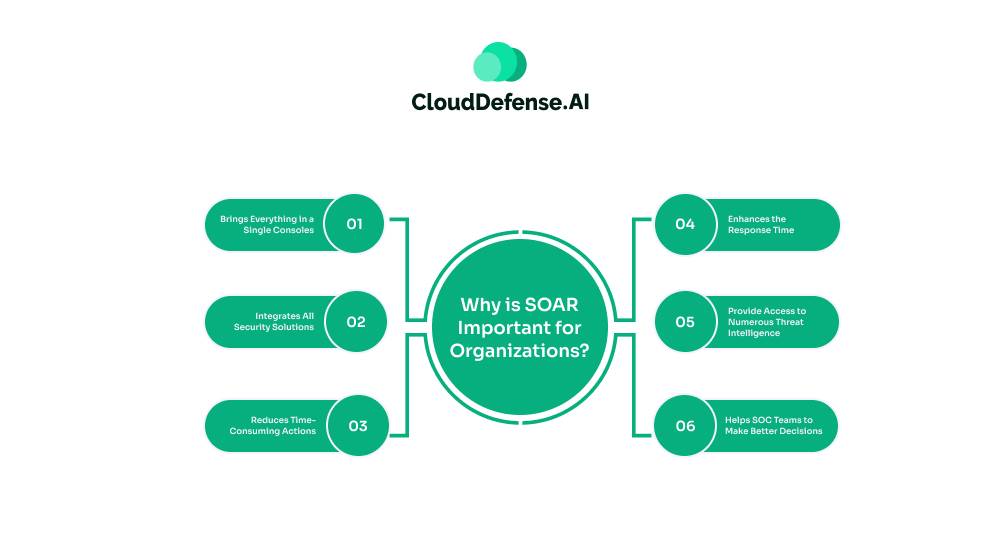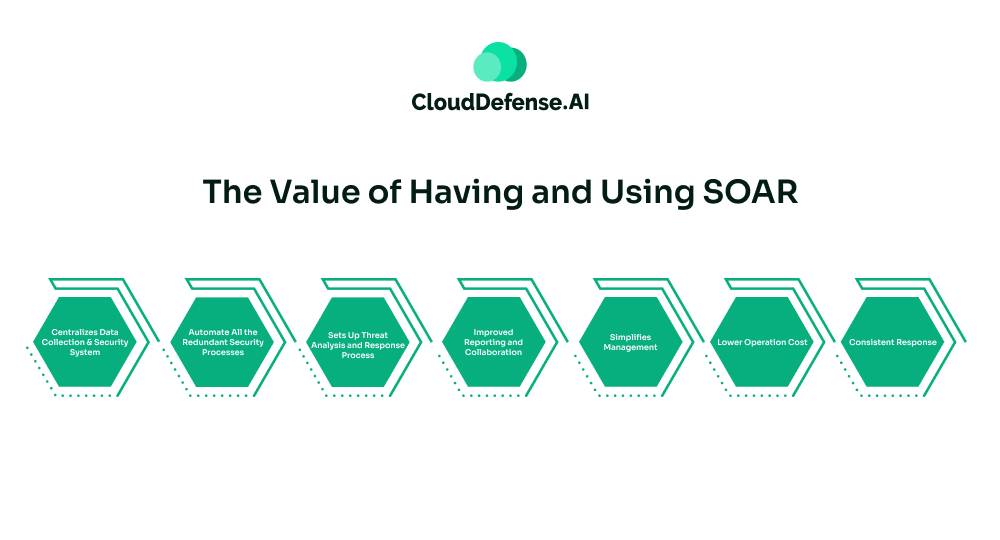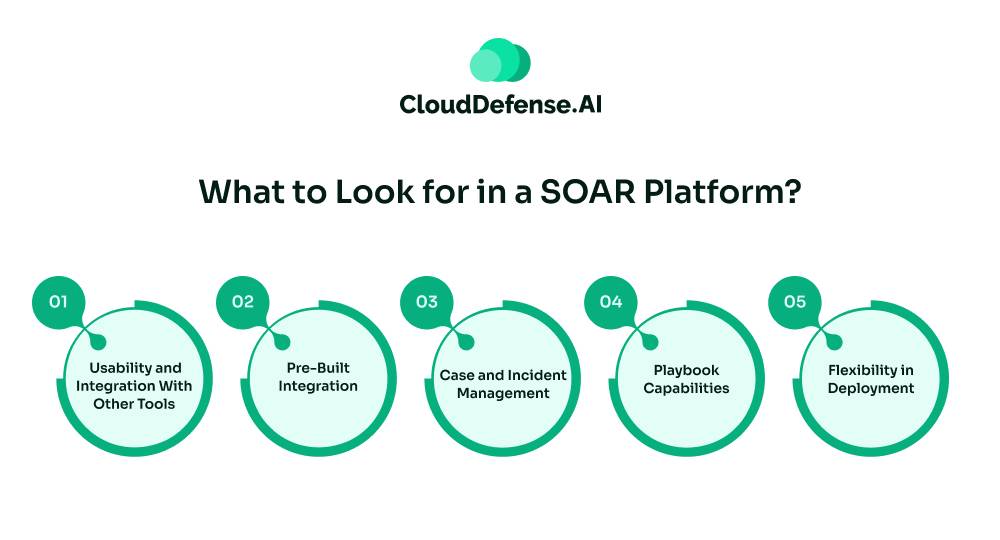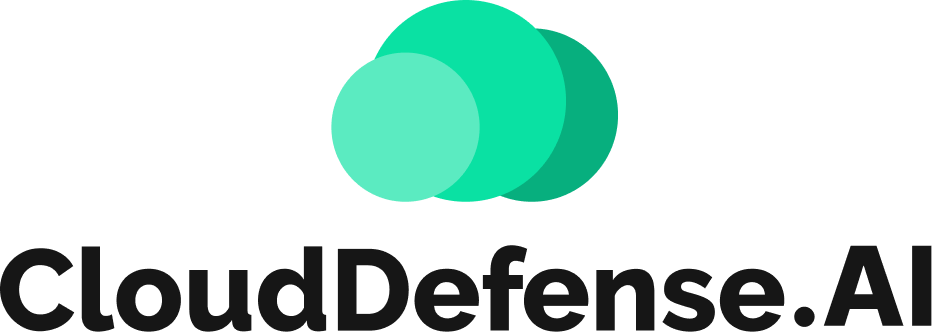What is SOAR?
Security orchestration, automation, and response, or SOAR refers to the stack of security tools, services, and technologies that allows security teams to consolidate threat data and automate the response process. It integrates all the tools and technologies and helps in devising a response plan to enable organizations to prevent all types of security events effectively.
SOAR can also be defined as a comprehensive approach that consolidates orchestration, threat intelligence management, automation, and incident response in one platform to enhance the effectiveness of security operations. With these capabilities, it is able to provide a comprehensive threat management system and reduce the stress on IT teams.
Besides, it also provides the option to understand, assess, and safeguard the organization from future incidents. Thus, SOC teams prefer this solution as it provides a central console to automate all the repetitive security tasks and streamline response workflow.
With the central console, the SOC team can easily manage all the alerts and respond to them quickly before they can make any impact. Faster detection and response can not only lower the impact of data breaches but also reduce the data breach lifecycle and cut down on breach costs.
How Does SOAR Work?
All SOAR solutions combine three primary components to proactively detect and eliminate cyberattacks. They combine the functions of threat and vulnerability management or orchestration, security operation automation, and security incident response in one platform and enable the team to enhance the security posture.
Security orchestration encompasses the technologies that eliminate threats while automation covers the tools and technology for automating the operations. This solution ingests all the threat data and activates playbooks that automate incident response workflow.
Then, through various processes and leveraging machine learning, organizations can assess all the data and devise automated incident responses to address security threats. To understand in detail, let’s explore how each component works:
Security Orchestration
Security orchestration enables the SOAR solution to connect and integrate separate internal and external tools into an organization’s security system. The tools usually include endpoint protection platforms, firewalls, intrusion detection and prevention, vulnerability scanners, SIEM, endpoint security, behavior analytics, and many third-party tools, and they are consolidated into central management.
As SOAR connects and coordinates tools into the platform, it is able to gather a lot of threat data, enabling better threat detection, threat context, and collaboration. However, the increase in threat data also leads to more data ingestion, analysis, and alerts which can be tiring for the security team.
Security Automation
Security automation is all about streamlining and automating low-level repetitive security tasks like alert prioritization, managing support tickets, event enrichment, and many more. This component also allows SOAR to trigger automated actions of different tools and connect various tools together to automate complex security tasks.
SOAR basically ingests all the threat data and analyzes them to create automated processes for many manual tasks. Playbooks play a vital role in SOAR because different playbooks can be connected together to complete sophisticated security tasks.
Processes like managing user access, assessing query logs, vulnerability scanning, ticketing checks, and other manual time-consuming processes are mostly automated by SOAR. Importantly, it also leverages AI and machine learning to gather contextual insights from analysis that help in making suggestions, prioritizing threats, and automating specific responses.
Security Response
The security response of SOAR solution provides the security team with a central management system through which they can manage, plan, monitor, and coordinate how they can respond to different security threats.
The central management system provides the platform for sharing threat intelligence and collaboration across security, system, and network teams. It keeps every team updated regarding responses to security threats and enables post-incident response tasks.
This component of SOAR is highly dependent on orchestration and automation as they lay the foundation for automated responses to threats. Automated response not only offers high accuracy and risks of human error but also significantly reduces the time to respond to threats.
Why is SOAR Important for Organizations?

Every organization, from small-scale to large enterprises, faces a lot of cyberattacks on a daily basis and it is increasing rapidly as organizations get more reliant on the digital world. As cyber threats are also getting more sophisticated and malicious, the need for effective security approaches is increasing.
That is why, SOAR has emerged as an important solution because it enables organizations to proactively detect and mitigate cyber threats. It has revolutionized the way organizations detect, analyze, and respond to various cyber threats on a daily basis.
Moreover, with SOAR, the security team can orchestrate how the tool should react to events and mitigate the threat while reducing time to response and overall budget. Besides, there are many other reasons that make SOAR an important solution for every organization and they are:
Brings Everything in a Single Console
With a SOAR solution, the security gets a centralized console through which they get to see all the threat information that they need to assess and respond to threats. It provides them with information on all the automated processes for different security tasks.
Integrates All Security Solutions
An important reason that makes SOAR important for organizations is that it connects all the existing security tools, including third-party tools for a comprehensive approach to threat data collection and incident response. The SOC team can get contextual information on threats and design threat responses accordingly.
Reduces Time-Consuming Actions
False positives, time–consuming manual processes, and repetitive tasks take up a lot of resources of an organization. However, the implementation of SOAR helps in reducing false positives and automates a lot of security tasks.
Enhances the Response Time
SOAR is widely preferred by organizations as it enables security teams to proactively detect and respond to threats by automating a lot of security processes. It plays a significant role in cutting down time for mean time to detect and mean time to respond to security incidents.
Provide Access to Numerous Threat Intelligence
SOAR ingests and aggregates threat data from various platforms like firewalls, threat intelligence platforms, SIEM, and others, enabling the security team to have a detailed insight. It allows analysts to conduct a deeper investigation after a threat or for a potential threat.
Helps SOC Teams to Make Better Decisions
The solutions come equipped with numerous premium features like automated alert prioritization, an inbuilt playbook, drag-and-drop, and many others. Moreover, analysts are fed with a lot of data on different security events. Thus, the solution makes it easier for everyone to make decisions with better accuracy backed by data.
The Value of Having and Using SOAR

For organizations of every size, SOAR has become a valuable security tool for minimizing the impact of different security incidents. When an organization implements SOAR in their environment, it benefits them in different ways that range from maximizing security investment and mitigating security challenges to curbing legal liabilities. Here are certain factors of SOAR that make it valuable:
Centralizes Data Collection and Security System
SOAR solution completely consolidates all the tools and threat data in a centralized location to provide analysts with complete visibility and respond to threats quickly. It also enables the teams to improve their productivity and the organization’s security posture.
Automate All the Redundant Security Processes
By gathering all the required threat data and integrating necessary tools, SOAR does all the manual security tasks and takes care of different stages of the security incident lifecycle. In many cases, it automates the response process with little to no human presence. Thus, it is able to increase response time to incidents, lower security incident costs, and improve the productivity of analysts.
Set Up Threat Analysis and Response Process
This security solution helps analysts set up the threat analysis and response process by leveraging a large pool of threat data. It also utilizes pre-built playbooks to prioritize and scale up the automated response process that will help in mitigating large numbers of threats as the organization grows.
Improved Reporting and Collaboration
It brings all the reporting and analysis information into place and improves information sharing among all the teams, leading to enhanced collaboration. The centralized dashboard makes it easy for everyone to get updated regarding threat information and make better as well as quick responses.
Simplifies Management
Since it combines all the security tools, technologies, and systems into one platform, it becomes easy for SecOps and IT teams to stay updated on alerts and current threat posture. Teams can not only collaboratively respond to potential threats but also investigate security incidents, leading to real-time collaboration for responding to security incidents.
Lower Operation Cost
SOAR solutions have significantly lowered the operation cost of many organizations as they automate a lot of security processes like threat analysis, managing login logs, response workflow, etc. It also helps increase the response time for all threats which helps in reducing threat mitigation costs. SOAR augmentation with analysts frees up a lot of time, which gives them the opportunity to focus on threat mitigation tasks.
Consistent Response
Another factor that makes SOAR a valuable tool for every organization is the consistency it maintains for all the incident response processes. As most of the incident response processes are automated with negligible human interference, it doesn’t involve any humans and ensures consistent response.
SOAR Use Cases

SOAR has been useful for most organizations since its arrival as it helps them in different security situations. Over the years, the number of use cases associated with SOAR has increased gradually. Here are some common use cases of SOAR:
Managing Security Operations
One of the common use cases of SOAR is managing and checking various security operations. SOAR is really useful during endpoint diagnostics where it helps in assessing connectivity to endpoints, opens tickets, closes playbooks, and enriches context.
It also comes useful in SSL certificate management where it helps in assessing the endpoint to determine whether the SSL certificate has expired or is about to expire. Moreover, it also helps in alerting users, checking the status after a few days, escalating the status of an issue, and terminating a playbook.
SOAR also integrates with vulnerability management to enable the platform to ingest all the information and enrich CVE data. It also assists in making queries for vulnerability context, terminating playbooks, providing controls to analysts, and calculating threat severity.
Look for Threats and Responding to Security Incidents
Another popular use case of SOAR is that it assists in looking for security threats and responding to events. It helps in hunting for indicators of compromise by taking out IOC from files, looks for IOC across all the security tools, and updates the database.
It also plays a role in malware analysis by ingesting threat data from different sources, extracting the files, creating reports, assessing for malicious content, updating the database, and terminating the playbook.
SOAR offers cloud incident response where it ingests data from cloud-based tools, unifies security processes, integrates SIEM, enriches IOCs, hunts for malice, provides control to analysts for assessment, and makes changes in the database.
Automates Data Enrichment
SOAR has been instrumental in automating data enrichment processes which are indicators of compromise enrichment and allocating security incident severity.
In IOC enrichment, SOAR helps in collecting data from varied sources, getting indicators for detonation, enriching hashes, looking for malice, updating the database, and onboarding analysts for investigating threat data for enrichment.
For allocation incident severity, SOAR involves checking others to evaluate whether indicators have been assigned any vulnerability score and to allocate severity. It also involves analyzing endpoint and username to check their presence on the critical list and finally assigning critical severity.
Managing Security Alerts
One of the common and well-known use cases of SOAR is managing varied types of security alerts, which usually include user login failure, endpoint infection, malicious login attempt, and phishing enrichment.
During a malware infection, SOAR, through orchestration, ingests threat data from the endpoint solution, enriches it, cross-checks with the SIEM solution, alerts analysts, eliminates malware from the endpoint, and updates the database.
In the phishing enrichment and response process, SOAR ingests phishing content, activates a playbook, automates specific tasks, extracts IOCs, checks for false positives, and reports to the SOC to generate a response.
When specific attempts of failed user login arise, SOAR, through orchestration, triggers a playbook to assess the attempts, engage users, assess their response, retire the password, and close the playbook.
On occasions of logging in to the system from an unusual location, SOAR becomes useful in orchestrating the response. It looks for malicious access attempts by assessing the CASB and VPN, cross-referencing the IPs, determining whether there is a breach, generating a blocking process, and closing the playbook.
SOAR vs SIEM vs XDR
SOAR, SIEM, and XDR come with the same capability and core function where they identify security threats and collect data. Despite having the same goal, each of the solutions performs uniquely. Here we will take a look at how these solutions are different from each other:
SOAR vs SIEM
Both SOAR and SIEM have the primary function of collecting and aggregating data from different tools and they are widely adopted by SOC teams in different organizations.
At its core, SIEM collects, aggregates, and identifies security incidents and categorizes them accordingly. It is mostly used for logging and managing a lot of security events data for SOC teams. On the other hand, SOAR also enriches collected threats in the same manner but it takes an extra step by automating complex incident response processes through playbooks and integration of tools.
SIEM offers useful features like incident detection, monitoring, and alerting which are really useful for organizations in adhering to compliance requirements. However, the primary issue associated with SIEM is that it comes with a high price point and it is not scalable. This is the reason many organizations prefer SOAR because it is a value-oriented security solution that utilizes SIEM’s intelligence data to prevent all possible threats.
SOAR vs XDR
Like SIEM, XDR also shares a few similarities with SOAR solutions but they operate quite differently. XDR works by cross-referencing threat data and security alerts to detect and respond to cyber incidents. It collects all the threat data from the cloud, network, and endpoints and leverages it to automate a lot of complex incident responses. XDR has a lot of use cases in the industry due to its simplified integration capabilities and ability to detect threats in real time and automate threat hunting. However, the area where SOAR gets the edge is the orchestration capability that simplifies and boosts up the threat response process. Thus, XDR is often used along with SOAR and SIEM for a comprehensive threat response.
Nowadays, vendors are coming up with choices where they are blurring boundaries between SOAR, SIEM, and XDR. They are providing SIEM solutions that have the capability to respond to threats and offer data logging like XDR.
What to Look for in a SOAR Platform?

Considering the SOAR solution for automating security incident response will be an easy task for you. However, confusion arises when you have to choose between different SOAR products as you won’t know which platform will rightly suit your organization. Even though the working is the same, there are certain factors you need to consider while making a decision. Here are the factors you need to consider:
Usability and Integration With Other Tools
When looking for a SOAR platform, your team should consider a platform that is easy to use and offers seamless integration to all the existing tools. They also need to make sure the tool ingests all the threat alerts from the existing detection tool and easily executes playbooks that help in threat enrichment and response.
Your team needs to assess how many actions can be performed by the platform and depending upon organizational requirements, they should consider the platform.
Pre-Built Integration
Integration is a vital aspect of the SOAR platform so the platform you choose must come with pre-built integrations. You should assess how much integration the vendor offers and also at what frequency. In addition, you also need to check whether these pre-built integrations are offered for free or additional charge.
Case and Incident Management
Another consideration you need to take into account is the case and incident management offered by the SOAR platform. Assess whether the platform native case and incident management and customization of the incident timeline. For effective incident management, you should look for a SOAR platform that offers post-incident documentation and review.
Playbook Capabilities
It is important for the SOAR platform to offer a real-time flow of playbooks for each incident and an option to nest playbooks. If you need to make custom playbook tasks, then you should assess whether it offers automated or manual customization. It would be helpful if you opt for a platform that enables your team to transfer tasks across different playbooks.
Threat Intelligence Integration
In today’s scenario, where cyber threats are evolving rapidly, it is vital for SOAR platforms to maintain integration with threat intelligence platforms. This integration with SOAR enables the SOC team to be fed with accurate information that helps them make informed decisions.
The integration of threat intelligence into ongoing incident investigation helps in boosting up the process and identifying all the malicious activity present in the network.
Flexibility in Deployment
When considering a SOAR platform, you should assess the flexibility it offers during deployment because it will ensure agility and scalability. Besides, you also need to assess the segmentation capability of the platform as it is needed for establishing communication in the network. It will also be useful to check whether it supports multi-tenancy and scalability options for multiple tenants.
Before we make an end to this guide, we would like to introduce you to some frequently asked questions.
FAQs
Why is SOAR Vital for Every Modern Organization?
SOAR with advanced capabilities to consolidate all the security tools and automate multiple security tasks has become vital for most modern organizations. Most importantly, its security team orchestrates security responses that enable the organization for a more proactive approach and speed up response time.
What are the Primary Components of the SOAR Platform?
A usual SOAR platform comes with four primary components where each performs specific tasks to help the platform achieve the main goal. The four components are security orchestration, automation, threat intelligence, and incident response.
How SOAR Platform Helps Organizations Improve Incident Response
When an organization implements a SOAR solution, it helps in improving the incident response capability of the team by a large margin.
It completely automates the process of collecting and analyzing threat data from different sources and coordinates the incident response across various tools. It helps in generating playbooks for different security procedures which ultimately aids in improving the incident response process.
What is the Primary Difference Between SOAR and SIEM?
SOAR solution is all about ingesting threat data from multiple sources and providing alerts to security through a centralized console. SIEM also performs in the same way but sends alerts to security analysts and doesn’t take part in automating incident response.
Conclusion
In today’s complex IT environment, where security breaches have become common, the need for proper incident response tools has become more important than ever. It has become a necessity for security teams to adopt tools to adapt to never-ending security alerts and deal with false positives. Therefore, the SOAR platform has become a point of interest for its proactive approach. It offers a single platform to quickly respond to security threats and assess the pattern to prevent such threats in the future. Tools like SOAR can help improve your organization’s security future and fortify threat defense.







